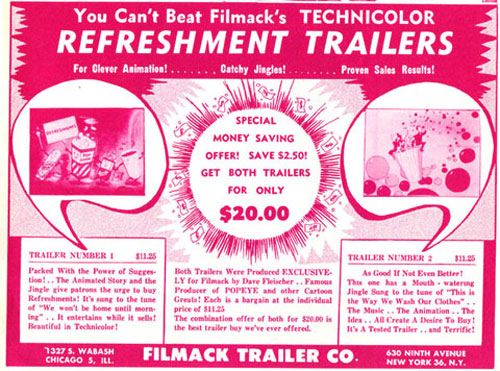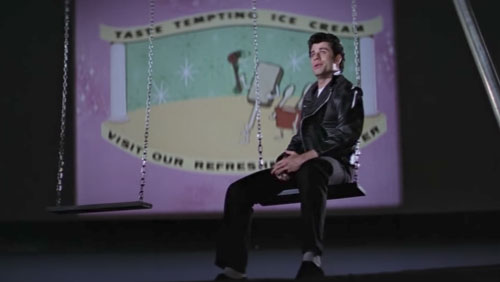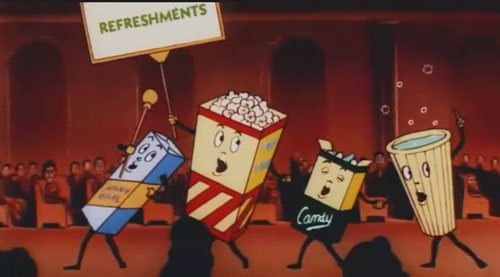Get Yourself A Treat
How movie theaters nudged film-goers out of their seats with short clips designed around the hard sell.
Editor’s note: Hey all, Ernie here—just wanted to let you guys know I’m handing the reins over to Andrew Egan once again. (If you want some of my thoughts on things, I did a recent interview with LetterList.) Last time, he told us about a time-storing device; this time, he has a stalling tactic of sorts. Check it out!
Sponsored By … You?
If you find weird or unusual topics like this super-fascinating, the best way to tell us is to give us a nod on Ko-Fi. It helps ensure that we can keep this machine moving, support outside writers, and bring on the tools to support our writing. (Also it’s heartening when someone chips in.)
We accept advertising, too! Check out this page to learn more.
“I will never be comin’ back to your ‘Alamo Drafthouse’ or whatever. I’d rather go to to a regular theater, where people are actually polite.”
— A quote from a somewhat famous clip created by Alamo Drafthouse, a Texas institution known for curating a better movie watching experience. The movie theater chain made headlines around the world when it used an angry customer’s recorded complaint in one of its snipes. Running before the trailers (or previews), the snipe is any material that runs before a feature and is typically promotional information for a specific theater. The infamous Drafthouse snipe sought to inform patrons not to use their phones during the movie, which has become a common use for snipes in recent years (see this example featuring the stars of Minions).

An early Filmack ad. (via Cartoon Research)
The company that gave snipes their power and prominence
The evolution of Filmack Studios, a Chicago-based production company founded in 1919, is very much tied the evolution of the snipe. The studio took a bit of a left turn compared to other studios of the era; the company avoided traditional feature fare and concentrated on the burgeoning trailer market, while also producing newsreels, animated shorts, and other promotional materials. The animator chairs were particularly busy; Walt Disney is said to have done freelance work for the studio in the 1920s, according to the Chicago Tribune, while animator Dave Fleischer worked with the company in the 1950s, decades after he and his brother, Max, had attained fame with the Popeye cartoon.
“There were quite a few Hollywood animators moonlighting on snipes at the time, so it wouldn’t be surprising to find someone like Dave Fleischer doing work like this,” animation historian Jerry Beck told the Tribune in 2003.
“They weren’t the only company making snipes, of course—a casual analysis of the Tumblr 35mm Snipe Films suggests that many other companies were active in the endeavor, but Filmack was by far the best-known.
By the time the Fleischer started working for the studio, Irving Mack, the company’s founder, had noticed that concession stands had become a significant contributor of movie theater’s revenue. To capitalize on this trend, Filmack commissioned a series of live action and animated snipes. The most famous of which, many of you (especially Tedium readers), will recognize.
six
The total number of frames in the animated snipe, Let’s All Go to the Lobby. For an iconic but admittedly obscure piece of pop culture, some surprising details are still unknown about its production despite one film scholar’s impressive attempts.
“Let’s All Go to the Lobby,” the funnest hard sell ever created
If there’s an authority about the history of Let’s All Go to the Lobby, it’s film historian Daniel Eagen (it’s very strange for me to type Egan that way).
As part of his 2009 book America’s Film Legacy: The Authoritative Guide to the Landmark Movies in the National Film Registry, which chronicles the stories of historically important films tracked films in the National Film Registry, Eagen took a close look at the short-but-memorable snipe. His interview in the book with Robbie Mack, the firm’s current president, forms the basis of what we know about the snipe.
It might have been produced in 1953 or 1955 but no records exist (the Library of Congress originally said 1951, something supported by an ad on 35mm Snipe Films), having been lost or discarded a few years later. Eagen did uncover a few interesting tidbits.
According to company promotional materials from the ’50s, Let’s All Go to the Lobby was made by Dave Fleischer, of Popeye fame, and was sold for a whopping $11.50 a copy ($105 and change today; this number also differs in the LOC information).
The current Mack in charge of Filmack estimates that 80 percent of independent theaters have run the snipe at one time or another. When estimating the total population of people that watched Let’s All Go to the Lobby in theaters, Eagen writes, “Consider that the film may have been screened three or four times a day, and hundreds of theaters, for decades.” (Not to mention the number of films and movies that reference it to set a certain time period.)
One 1969 Los Angeles Times article, meanwhile, puts the credit for the trailer’s existence in the hands of National General, a theater chain formed in 1951 after a consent decree forced the major studios to sell their existing theaters. National General took advantage of snipes: “We were the first to make a short trailer, hustling it out to the concession stand,” explained the company’s then-president, Irving Levin. “That trailer helped make us what we are today.”

John Travolta in Grease singing “Sandy” with basically just a snipe as a background.
The long pop-culture shadow of “Let’s All Go to the Lobby”
Snipes are not an insignificant part of pop culture. But Let’s All Go to the Lobby holds a special place for its sheer ubiquity. It’s been preserved by the Library of Congress as a culturally significant film. The Simpsons, the standard-bearer for parody, hasn’t shied away from taking a shot at this piece of old-film nostalgia, for example having Mr. Burns take a turn at singing the jingle in one episode.
Nearly two decades later, The Simpsons Movie took a fresh stab at the joke; though it didn’t make the cut, it was added as a special feature to the DVD.
For its popularity, Let’s All Go to the Lobby isn’t a touchstone for cinephiles. The Library of Congress was brutal in its assessment when it wrote, “The actual animation of the snipe isn’t particularly good; by the standards of even the weaker studios of the early ’50s, it’s downright primitive.” So much for Popeye. But they continued, “What kept the snipe alive in the public’s memory and outlast any other trailer of its kind was not Dave Fleischer’s animation, but Jack Tillar’s composition. Which, as Tillar says, wasn’t particularly original.”
Eagen noted the melodic occurrence in his exhaustively detailed, America’s Film Legacy, “The melody for the background music was identified at the time as ‘We Won’t Be Home Until Morning’, but this is known under several titles, such as ‘The Bear Walked Over the Mountain’, and ‘Malbrouk’ or ‘Marlborough’. Music historians Roger Lax and Frederick Smith trace the tune back to 1783’s ‘For He’s a Jolly Good Fellow’, but note that it may date from the Crusades. Beethoven used it in his 1813 ‘Battle Symphony’, Marie Antoinette sang it as a lullaby, and Napoleon was rumored to have been humming it as he started his Russian campaign.”
And you can still buy this snipe in full film glory today, from Filmack, which has—shockingly—survived into the present day.
200
The number of “stock” trailers that Filmack sells today, at prices varying from $100 to $900 depending on the length and type of film, according to a 2013 Chicago Tribune article. Unlike most types of films, whose intellectual property is licensed, Filmack sells it outright in a way similar to stock photos. The company, while surviving to the present day, has struggled with the increasing number of theaters offering their own swipes due to simpler digital technology, along with the move from 35mm film to digital.
You might not have known the specific word for a snipe, but you saw them any time you got to a movie on time, which is to say at least twenty minutes before the scheduled showtime. (These days, they often use cheesy 3D effects, such as in this 1997 clip from Filmack competitor Pike Productions.)
As our media consumption becomes increasingly focused on home use, we lose the little nuances that made experiencing a movie unique. Snipes, along with sticky floors, the smell of liquified margarine and allocating $40 for food I could have bought at the gas station around the corner for less than $10, helped frame my mindset going into a movie. The movie experience is singular, unlike anything else and it’s why I appreciate the Alamo Drafthouse approach.
To be fair, snipe knowledge (does that make me a sniper?) also serves as a badge of honor. The people that show up early are excited to watch the movie and aren’t just looking for something to do. They remember the minutiae of the experience, especially when it’s set to a ditty that captivated Napoleon and Marie Antoinette and the Library of Congress.
Not bad for primitive.
--
Andrew Egan is writer and editor of Crimes In Progress. His work has appeared in Forbes Magazine, ABC News, Atlas Obscura, Tedium, and more. He is a graduate of the University of Texas at Austin. His novel, Nothing Too Original, is available now for Kindle and paperback. You can visit his website at CrimesInProgress.com.
:format(jpeg)/2017/08/tedium081517.gif)
/2017/08/tedium081517.gif)



/uploads/andrew_egan.jpg)